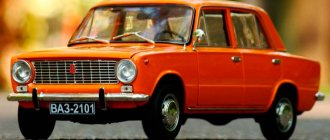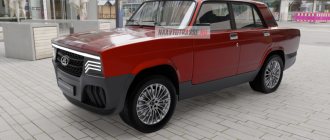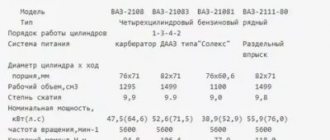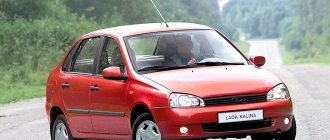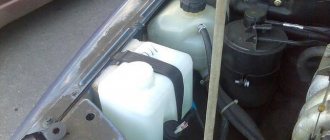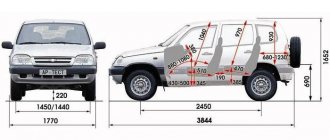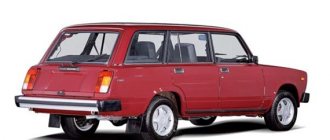Reviews from VAZ 2105 owners
VAZ 2105, 1997
We bought a VAZ 2105 in half with my brother from a relative in 2010. The family urgently needed a car, because they needed to take their nephews to school, there was not enough money, and at that moment my cousin was selling his “Swallow”. The price was right, they came and took it away. At first, we were a little distrustful of this “Five” - after all, it’s a domestic auto industry, and even rear-wheel drive. They were afraid that I wouldn’t be able to control the car at all, and my brother was afraid that he wouldn’t be able to drive normally and would have to undergo frequent repairs. Everything turned out to be not so scary. I got used to it after a couple of days of driving - the steering wheel is not that tight (only Moskvich’s is really tight), the car is absolutely obedient and controllable. For a relatively small engine capacity, the VAZ 2105 drives with dignity and agility, accelerates well, which is important for safety. The suspension is typical “Zhiguli” and is stiff in order to hold the car when entering a turn at speed, and at the same time soft enough - there is no discomfort from long trips. The interior is comfortable, there was always enough space for both children and shopping. Sometimes I dropped off friends - they all fit in. The window regulators are easy and convenient to use; nothing gets stuck or creaks. The stove is excellent, in winter I had Tashkent in the car in 10 minutes, you can safely drive with the windows open. I don’t really like the interior itself - the chairs are comfortable, but the color is somehow not very good. But I stopped paying attention, okay. In general, we drove for 2 years, I don’t regret anything. Yes, there were repairs - the fuel pump broke once, I refueled at a bad gas station. I also changed the generator - I noticed in time that the battery was running low, and immediately called a tow truck (on the previous car, the block gasket burned out due to the fact that the engine began to overheat). My brother repaired something in the suspension once, I still didn’t understand what he was doing there. In general, for beginners, I recommend the VAZ 2105.
Advantages
: low price. Small expense. Very cheap spare parts. Manual Transmission.
Flaws
: ugly upholstery.
Vlada, Moscow
VAZ 2105, 2007
Hi all. I have a VAZ 21053 from 2007, I used to drive a VAZ 2109 from 1990, I bought a “five” recently, I looked at a lot of cars, but I came across some with a lot of problems. There are mainly only Logans on the market, there were also “Classics”, but everything is very sad. And one day my friend said that he knew where there was a “five” for sale. We gathered, came, and looked. VAZ 2105 is blue, well-groomed, the music is decent, the body is not damaged and the interior is not a mess. The most important thing is that it’s not rotten at all. We discussed what and how, and about a week later I took it, at that time the owner did not drive it, he had another car. When I bought it, frosts began. The heater is not very warm compared to the “nine” (low panel), the windshield takes a long time to come off, and the speed switching is also a bit harsh. Another disadvantage is that it is a little noisy in the cabin. I think this is due to the condition of the roads (we have them like a washboard), the antifreeze also drains very, very slowly, I can’t find where, and even on large bumps the front left wheel catches on the fender liner. I will soon be working on eliminating these “jambs”. And so, in principle, it’s a normal car, you can drive it. I think that this is not the worst option, and in terms of years it is not old, not the early 80s. If you watch on time and drive carefully, the car will carry you for a long time. The VAZ 2105 reaches 100 km/h quite well, in the spring I’ll check its true capabilities, this car can do more, but now it’s winter and it’s scary to drive fast. I recommend this car as the first one for those who are just starting to drive. I'm 20 years old now, this is the right car for my age. Good mood to you all.
Advantages
: inexpensive, the car runs on your own money. Availability of spare parts. Self-repair.
Flaws
: a bit noisy. Sometimes the electrics are capricious.
Oleg, Kostroma
VAZ 2105, 2010
Why did I take the VAZ 2105? There are several reasons for this: softness, good visibility of the “classic”. It is easy to change gears without squeezing the clutch, since the gearshift knob is connected directly to the gearbox. I like the appearance of the VAZ 2105 more than the 2107. The ugly radiator grille of the 2107 spoils the whole look. Even though the instrument cluster of the VAZ 2105 is poorer than that of the 2107, the absence of a grille is much more important to me. And what is the need for a tachometer, especially since this is no longer a carburetor car. In all other respects, the cars are completely identical - both inside and outside. Assembly - VAZ. That is, there are no “jambs” of the Izhevsk assembly here. Yes, the glove compartment is a little crooked, the rear bumper on the left is a little lower than on the right. This is typical for all the latest “classics”. It's such a conveyor belt. After the purchase, I installed anti-corrosion protection, installed good protection, heated mirrors, music, and, well, tinting. Color - “quartz”. In terms of driving performance, everyone already knows everything; nothing has changed here since the 70s. The car runs smoothly, softly, pleasantly. At high speeds it requires a well-made camber, otherwise it will throw around (after all, it is rear-wheel drive, and the aerodynamics are poor). Good for trips to the country with the family - everyone will fit, and sufficient ground clearance (especially with 14 discs) allows you to get much further than you expect. The engine power was a very pleasant surprise. The 1.6 injector literally jumps out from under you. The VAZ 2105, of course, eats like a diesel locomotive, that is, a Niva - after all, the engine is essentially the same. The program can be “changed”, there will be much less food, but I didn’t do this, because I think that the car should be stock. My consumption was around 13-15 liters. But it starts in any frost with half a turn. When I changed the spark plugs after the first year of operation, they were a pleasant reddish color. So everything is normal. The car has good sound insulation; the engine is almost inaudible at low speeds. Another advantage is that it is undemanding in terms of fuel quality, oil quality, and the like. There is a chain in the engine, so nothing will break anywhere. In two years of owning a VAZ 2105, I drove only 9,000 km. Nothing has ever broken, except for one single “disease” - the stove motor. Like frost, like whistling. Therefore, I regularly stopped by to change it under warranty. In general, this can be treated by installing a motor on the bearing, but I was too lazy to do this. Overall: a good, very reliable, even comfortable car with good visibility and an attractive price at that time.
Advantages
: reliability. Softness. Review. Comparative interior comfort. Clearance. Nice stove. When I bought it, the price was 99 thousand for disposal. Now, of course, this is no longer the case.
Flaws
: Outdated design. Poor aerodynamics. Minimum amenities in the cabin.
Alexander, Samara
VAZ 2105, 1996
Great machine for beginners. VAZ 2105 is not so sorry to rub, scratch, hit. Economical, my consumption was somewhere around 8 liters per 100 km AI-92 in the city. Spare parts for three kopecks, at any stall. I drove very well across the field with four people in the cabin, but in winter I couldn’t get going out of the blue, it was slipping (Velcro tires, which I drove on practically without taking them off for 2 years). There was enough comfort on winter non-studded Goodyear tires, but what was missing was sound insulation, especially with my 4-speed. If the speed was above 90 km/h, you had to yell for the passenger to hear. There were no serious breakdowns at all during the entire period of ownership of the car, with the exception of the case when I gave the car to a friend for a ride, he “drifted” it without adding oil as a result, oil starvation and engine wedge. I'm not complaining about reliability. There were only 2 moments when the VAZ 2105 started up for more than 10 minutes, and that was after 2 weeks of inactivity in winter. We've done it before. And now a friend has a 2005 7 and it’s almost all fallen apart.
Advantages
: the ability to fall sideways in the snow. Cheapness. The cheapest spare parts. Economical. High ground clearance. Can be repaired in the field, on the knee.
Flaws
: uncomfortable fit. Poor sound insulation. Disgusting mounting of wipers. Poor security. There is no cabin filter. No tachometer.
Alexander, Moscow
VAZ 2105, 1996
Over the years, I have driven the VAZ 2105 a little less than 55 thousand kilometers - almost the same as when I bought it. Without special preparation of the car, I went to Finland 1 time (in 2010), 2 times to Vitebsk, Belarus (in 2010 and 2011). I would have gone later, but due to circumstances I didn’t have the chance. During the entire period of operation, it was not driven only once - almost immediately, in the fall of 2011, the battery of the previous owner was covered with a copper basin. The appearance of the VAZ 2105 is a C grade. I still like this chopped clumsiness. One for comfort - for the rear sofa (very comfortable with a girl) and an always working stove - so I would have given it a 0. 4 for reliability - I guess I was just lucky. Listening to the stories of other “Classicists”, I understand that I wasn’t particularly involved in repairs (I didn’t even accumulate a collection of spare parts). The driving performance of the VAZ 2105 is 3 - here you need to understand that I am trying to objectively evaluate a technically and generally tired car. My eggplant with Shell semi-synthetics in the engine and their own mineral water in the box and rear axle starts easily at -20 and does not stall when starting to move. But at 18 years old, 120 on the Ring Road is cruising speed for him. If necessary, I drove half the ring and at 130 and up to 140 it is still possible to accelerate it (with a design of 150 and a 4-speed gearbox). Yes - it roars (4500 rpm at 120), yes - if there is no habit, passengers are scared, but I have driven like this for many years, and I know that my car is capable of this. Safety - in November last year, when I was driving at a speed of about 60 km/h and a distance of approximately 1.5 - 2 car lengths from the yard arch, I realized that the Mini Cooper, driving out of this very arch, was not going to give way to me. I actually slowed down to about 40 and took him on board. My finger was knocked out; my colleague, who was sitting in the passenger seat, did not receive a bruise. Helped out? Perhaps that helped out.
Advantages
: cheap spare parts. Unpretentious suspension. "Old school".
Flaws
: technically and morally outdated. Lack of sound insulation. Rotting.
Dmitry, St. Petersburg
VAZ 2105, 1999
Well, what can you expect from a VAZ 2105 for 30 thousand? Judging by the reviews, I expected much worse, but after 10 thousand km I have only changed the diode bridge and the oil. Now the brake fluid reservoir is leaking (it has burst), but it drives without problems. The VAZ 2105 starts up as it should (thanks to the previous owner for the electronic ignition). At -33, for example, I’m the only one in the group that starts it). BMWs and Fords from the 80s sit idle. Maintainability is 100%, the back was pulled out with a jack and hammer, I bought the cover used for 500 rubles. A VAZ is like a VAZ, I don’t see anything criminal in it, why does everyone criticize them so much. In addition, you can drive a VAZ 2105 well in winter in open parking lots, taking turns sideways. Of course, there is no comfort, safety is low, dynamics are not brilliant, but this is not a Mercedes for 1 million, what do you expect from it. The VAZ 2105 justifies its money by 300%. For the price of a useless iPhone, we get entire Zhiguli cars in which you can move around and learn to drive. And having with you 1 thousand rubles, a hammer and pliers, you can always fix any breakdown, and you’ll still have enough left over for beer. In general, I'm pleased, and not because it's the first. The next step is the VW Golf IV.
Advantages
: spare parts in any supermarket. Price. She drives and drives forever, being a little less than completely broken.
Flaws
: strong passive safety. Comfort.
Dmitry, Voronezh
VAZ 2105, 2010
Pros - everything is cheap. You can change the pendant with every paycheck. 4 shock absorbers, 4 balls, pads - for all this I paid 3000 rubles. The magical “eternity” of spare parts. Everything that has already been changed has not yet broken. This is surprising, but for the 35 thousand km I drove. Immediately after the purchase, I changed only 1 shock absorber, 2 balls, and 1 pad. On the more serious side, we had to change the heater motor, radiator, generator, and clutch. Auto for a teapot. You need to understand the science of driving a car from the very bottom. This is the only way you will learn to roll sideways and not roll sideways when you need to. You will learn to storm small snowdrifts. You won’t feel sorry for attaching a dead car to yourself and dragging it to the nearest service station. You won't even have the fear of damaging the paintwork. Excellent visibility. Well, seriously, everything is visible. The windshield pillars on the VAZ 2105 are very narrow. Problems arise in rainy weather; the wipers clean only in the middle, with huge streaks of dirt on the sides. Now about the disadvantages of the VAZ 2105. Body. Over the course of 4 years, the threshold on the driver's side has rusted along the seams. In the 5th year it started to rust on the passenger side. Now the corrosion is the size of a fist and I don’t wash my car on purpose so as not to be sad. Ergonomics. My height is 187 cm. Zhiguli developed in me a short-armed, long-legged freak complex. Either you adjust by your legs and steer with the power of your thoughts, or you adjust by your arms and rub the characteristic stripes on your jeans with the steering wheel. I exaggerated a little, but I wasn't far from the truth. Awareness of insecurity. There is a small fear that the radiator will leak, the brake fluid reservoir will burst, the heater valve will leak, or the tire will go flat. Cooling system. I'm just indignant with her. It all started with the aforementioned stove tap - it flooded the storage shelf and all the trim underneath it. My short arms came in handy for replacement. All clamps must be tightened before each season. Even if you tighten them in time, it will still drip on the generator, the brushes or the diode bridge will cover, or all together, like mine. In general, this is the weak side of the VAZ 2105. Prestige. That is, the complete absence of it. Everyone is trying to hit your Zhiguli. Clutch. Either I'm not friendly with it, or it's defective, but the clutch does not have a fixed position. It always grabs in different places. Safety. For this reason, I have a panicky fear of traveling around the region and intercity.
Advantages
: in the review.
Flaws
: in the review.
Andrey, Omsk
The ancestor of the second generation of the “classic” Zhiguli family, the Soviet sedan VAZ-2105, appeared as a result of a serious modernization of the previous generation cars VAZ-2101 and VAZ-2103. Why are the “five” considered to be the second generation? This is primarily due to its appearance; instead of round ones, the car received rectangular headlights. The cars also differed in their body panels, although the frame and body manufacturing technology remained the same.
The first prototypes appeared in 1979, at the same time the first pilot production batch was produced. The Volzhsky Automobile Plant launched full-fledged serial production of VAZ-2105 cars at the end of January 1980.
The appearance of the VAZ-2105 car did not change throughout the entire production period, which lasted 31 years, if you take into account the pilot production batch of 1979. The interior also did not receive any special changes; it received only the necessary upgrades in accordance with safety requirements.
In 1982, a “luxury” version of the “five” VAZ-2107 sedan was created, and a little later, in 1984, the car began production of VAZ-2104 station wagons built on the basis of the VAZ-2105 sedan. By analogy with its predecessors, various modifications of the VAZ-2105 car were exported to various countries under the names Lada 1300, Lada Saloon, Lada Nova and Lada Riva.
At the end of December 2010, AvtoVAZ stopped producing it due to low demand for the VAZ-2105 model. By this time, 2 million 91 thousand VAZ-2105 cars of various modifications had already been produced. After production of the car was stopped in Tolyatti, it was planned to continue its production in Izhevsk, but this idea was abandoned.
VAZ 2107: model review
"Seven" is one of the iconic models in the Lada line. Initially, the modification of the VAZ 2107 was based on the traditions of the VAZ 2105, but AvtoVAZ designers largely modified and improved the model.
VAZ 2107 is one of the latest “classic” models, which was produced from March 1982 to April 2012. It is curious that according to the results of the 2021 study, 1.75 million people owned the “Seven” in Russia.
In Russia alone, the VAZ 2107 is currently owned by more than 1.5 million people
All basic vehicle data is indicated both in documents and in a summary table. It is made of aluminum and is mounted on the bottom shelf of the air supply box. The plate displays information about the model and body number, type of power unit, weight data, spare part numbers, etc. Directly next to the plate there is an embossed VIN code.
All model data is stamped on an aluminum plate
Curious facts about the "seven"
The VAZ 2107 car was extremely popular not only in the USSR and Russia. Thus, the “seven” became a cult car in Hungary, where it was often used not only for personal needs, but also in racing competitions.
And even in modern times, the VAZ 2107 never ceases to amaze car enthusiasts with its capabilities. Thus, in the Russian Classic Rally Championship in 2006–2010, the “seven” was among the winners. The model confirmed its confident position in 2010–2011 at the Russian Championship in automobile circuit racing.
And in 2012, the VAZ 2107 was equipped with a remote control at competitions in Astrakhan and also showed excellent results.
The car shows excellent handling and speed characteristics
Technical characteristics of VAZ 2107
The model is a classic rear-wheel drive sedan. There are no front-wheel drive modifications for the VAZ 2107.
The car was only slightly different in size from its predecessor, the “six”:
- length - 4145 mm;
- width - 1620 mm;
- height - 1440 mm.
The curb weight of the “seven” was 1020 kg, the total weight was 1420 kg. As on all VAZ models, the fuel tank volume was 39 liters. For the vast majority of owners, the trunk volume of 325 liters provided the necessary space for transportation.
The latest versions of the “seven” were equipped with a remote control for automatically opening the trunk
Initially, carburetor modifications of power units were installed on VAZ 2107 cars. Depending on the year of manufacture, the engine could operate with either a four-speed gearbox or a five-speed gearbox.
- An important feature of the engines on the “seven” is that until 1995 they were equipped with a breaker relay, which can be easily detected when braking with the handbrake.
- The braking system was inherited from the “seven” from the “six”: front disc brakes and rear drum brakes.
- The ground clearance of all VAZ modifications was not designed for off-road driving, but 175 mm of ground clearance makes it possible to cope perfectly with uneven road surfaces.
- In total, over the entire period of production of the VAZ 2107, the car was equipped with five types of engines:
- model 1.5 liter or 1.6 liter, 65 hp, 8 valves, carburetor);
- model 1.3 liter, 63 hp, 8 valves, timing belt);
- model 1.7 liter, 84 hp, 8 valves, mono injection - version for export to Europe);
- model 1.4 liter, 63 hp, version for export to China);
- model 1.7 liter, 84 hp, 8 valves, central injection).
The power unit is located in the front of the machine in the longitudinal direction.
Video: main characteristics of the machine
All about model refueling fluids
As mentioned above, the VAZ 2107, like all models of the manufacturer, is equipped with a 39-liter gas tank. This volume is quite enough for long continuous trips. Of course, in recent years, due to a sharp increase in fuel prices, the tank volume has become enough for only 3-4 hours of driving on the highway.
Fuel
Initially, the “seven” was refueled exclusively with A-92 gasoline. However, some of the latest versions of the model implied the use of diesel fuel (VAZ 2107 - diesel). However, diesel modifications of the VAZ 2107 did not gain popularity in Russia due to the high cost of the car and increased fuel consumption.
AI-92 fuel is the main filling fluid for the engine
Engine oil
Another filling fluid for the car is the oil in the power unit. AvtoVAZ engineers recommend that drivers fill the engine with lubricant that meets the minimum requirements of API SG/CD standards. This marking is usually indicated on containers with consumable liquid.
For VAZ 2107 engines, according to the SAE classification, the following oils are recommended:
- Lukoil Lux - 5W40, 10W40, 15W40.
- Lukoil Super - 5W30, 5W40, 10W40, 15W40.
- Novoil-Sint - 5W30.
- Omskoil Lux - 5W30, 5W40, 10W30, 10W40, 15W40, 20W40.
- Norsi Extra - 5W30, 10W30, 5W40, 10W40, 15W40.
- Esso Ultra - 10W40.
- Esso Uniflo - 10W40, 15W40.
- Shell Helix Super - 10W40.
Where oil is present, experts recommend changing the oil filter as well.
Transmission oil
It is also necessary to maintain an optimal level of lubrication in the gearbox - transmission. For VAZ 2107 with 4 and 5-speed gearboxes, the same types of transmission oils are used.
AvtoVAZ engineers draw the attention of owners that only special gear oil of groups GL-4 or GL-5 should be poured into the gearbox. The viscosity grade must be designated SAE75W90, SAE75W85 or SAE80W85.
It is important not to overdo it with pouring lubricant into the transmission: no more than 1.35 liters of oil can be poured into a four-speed gearbox, and 1.6 liters of oil into a five-speed gearbox.
When changing transmission oil, it is necessary to fill in a clearly defined amount of fluid.
Coolant
The VAZ 2107 power unit needs high-quality cooling. Therefore, all versions of the “Seven” have a liquid cooling system. It is based on antifreeze. In the 1980s, the use of antifreeze was not practiced in the USSR, so engineers used only antifreeze to cool the engine.
In recent years, car enthusiasts have been pouring both antifreeze and antifreeze into the expansion tank without any consequences for the operation of the car. In some cases, during the summer months it is even possible to use ordinary water as a coolant, but the manufacturer does not recommend adding water.
Operating a car without coolant can lead to overheating and engine damage.
Description of the salon
Having first appeared in 1982, the VAZ 2107 did not differ from its predecessors and competitors in any modern devices or design. However, even those little things that the manufacturer decided to introduce into the new Lada model played into the hands: the car became more convenient and attractive for drivers.
Interior trim
The interior trim was fully consistent with Soviet ideas about fashion. For example, higher quality plastic and wear-resistant fabrics were used. For the first time, the seats acquired an anatomical shape and received comfortable headrests. In general, the VAZ 2107 was the first in the manufacturer’s line to receive the title of a comfortable car for people.
Hard plastics and wear-resistant fabrics are used for interior upholstery.
Dashboard
However, if the interior, at the very least, stood out from similar AvtoVAZ models, the instrument panel was always made in strict accordance with existing standards. We can say that the dashboard is featureless, although it houses the tachometer and additional services of instruments and sensors.
On the panel there are only important devices, without decorations or frills.
This is probably why almost all VAZ 2107 owners try to somehow personalize the instrument panel in their cars. Some hang icons, others - flavors, others - toys... After all, a dull instrument panel affects the mood, so depending on capabilities and taste, drivers often resort to tuning this area of the car.
Gear shift diagram
The gearbox on the VAZ 2107 is needed to transmit torque from the engine to the transmission.
Design and construction
Compared to first-generation cars, the VAZ-2105 sedan received a different radiator grille, rectangular headlights with hydrocorrector, and the rear headlight unit for the first time combined brake lights, turn signals, side lights, fog lights and reversing lights. The car was stripped of almost all chrome; this was done to reduce the cost of production. Instead of chrome parts, they began to install black plastic or painted metal.
The frame of the VAZ-2105 car was similar to previous models, but new body panels gave it a more modern and even fashionable “angular look” by the standards of those years. The overall proportions of the car, and even the longitudinal inclination, have also changed. Thus, the unification of the VAZ-2105 sedan with the first generation cars (VAZ-2101, 02, 03,) was much lower than with the second generation (VAZ-2104, 07).
For the first time, all-stamped interior panels made of polyurethane appeared in the interior of the VAZ-2105 car (they were later abandoned). A heated rear window was already included as standard. A function for heating the side windows appeared, as a result of which the rotating triangles were abandoned, thereby making the glass one-piece. The seats with height-adjustable headrests were upholstered in black leatherette (in the mid-2000s, the car received seats from the VAZ-2107).
As a power unit, the VAZ-2105 was equipped with various engines with a volume of 1.2 to 1.65 liters and a power of 64 to 140 horsepower. The engines were both carburetor and distributed fuel injection, both conventional and rotary piston. In addition to gasoline engines, VAZ-2105 cars with a VAZ-341 diesel engine with a volume of 1.52 liters and a power of 50 horsepower were produced in small batches.
Review of the Lada 2105 model
The VAZ-2105 car was produced at the Tolyatti Automobile Plant (as well as at the KraSZ factories in Ukraine and Lada Egypt in Egypt) for 31 years - from 1979 to 2010, i.e. it was in production longer than any other VAZ model. By the end of the 2000s, thanks to the minimum configuration, the “five” was cheaper than each of the Volzhsky Automobile Plant models produced at that time - 178 thousand rubles in 2009.
The VAZ-2105 car was produced at the Tolyatti Automobile Plant from 1979 to 2010
Having replaced the first-generation Zhiguli, the VAZ-2105 received a more contemporary appearance at that time with angular shapes and matte black decorative elements instead of the previously used chrome ones. The creators of the new model sought not only to simplify assembly, but also to achieve an acceptable cost for the car . For example, the abandonment of chrome-plated parts made it possible to get rid of the long and labor-intensive technological process of applying several layers of non-ferrous metals to steel. Among the innovations that were not present on previous VAZ models were:
- timing belt (instead of the previously used chain);
- polyurethane panels in the interior, made by solid stamping;
- block headlights equipped with hydraulic corrector;
- combination of clearance lights, turn signals, reversing lights, brake lights and fog lights under one rear lamp shade;
- heated rear window as standard.
In addition, the rotating wind triangles on the windows of the front doors of the new car were removed, and side nozzles began to be used to blow these windows. The driver could now adjust the position of the side mirrors from the passenger compartment; height-adjustable headrests were provided for front passengers.
A very good car for the money, I bought it as my first car and didn’t regret it later. I drove it for 1.5 years, invested a little after the previous owner and hit the road! During operation, no special problems arose, just little things related to maintenance, you just need to change everything on time and take care of the car, and not wait until it falls off on its own! Possibility of tuning, a large selection of spare parts, and all auto stores have almost all spare parts, not counting disassembly ones.
Alexander
https://www.infocar.ua/reviews/vaz/2105/1983/1.3-mehanika-sedan-id21334.html
The rotating wind triangles on the windows of the front doors of the new car were removed, and side nozzles began to be used to blow these windows
More about tuning the VAZ 2105: https://bumper.guru/klassicheskie-modeli-vaz/tyuning/tyuning-vaz-2105.html
The VAZ-2105 body number can be found under the hood near the windshield closer to the passenger seat . The vehicle's registration data is indicated on a special plate located on the bottom shelf of the air supply box. In addition, the vehicle identification code indicated in the table is duplicated in the luggage compartment. To see it, you need to use a Phillips screwdriver to unscrew the screw holding the rear wheel arch trim and remove the trim.
The vehicle's passport data is indicated on a special plate located on the bottom shelf of the air supply box; next to the plate (1 with a red arrow) VIN is stamped (2 with a red arrow)
The summary plate shows:
- 1 - number used for selecting spare parts;
- 2 - manufacturer;
- 3 — conformity mark and vehicle type approval number;
- 4 — VIN of the car;
- 5 — engine brand;
- 6 — maximum load on the front axle;
- 7 — maximum force on the rear axle;
- 8 — marking of version and configuration;
- 9 - maximum permissible weight of the machine;
- 10 is the maximum permissible weight of the vehicle with trailer.
Video: introduction to the first version of the VAZ-2105 model
Modifications
VAZ-2105
The base model was produced in 1979 with a 1.29-liter carburetor engine producing 63.6 horsepower. It was equipped with a 4-speed gearbox.
VAZ-21050
The same model of the five, but with a 5-speed gearbox
VAZ-21051
Modification with a VAZ-2101 carburetor engine with a volume of 1.2 liters and a power of 58.7 horsepower, a 4-speed gearbox as in the basic version.
VAZ-21053
Modification with a VAZ-2103 engine with a volume of 1.45 liters and a power of 71.4 horsepower. It was equipped with both 4 and 5-speed gearboxes.
VAZ-21053-20
Modification with a VAZ-2104 injection engine with distributed injection, volume 1.57 liters and 82 horsepower. The gearbox is 5-speed.
VAZ-21054
A special modification for the needs of no less special services, such as the traffic police, the Ministry of Internal Affairs and the FSB. It was equipped with a VAZ-2106 carburetor engine with a volume of 1.57 liters and a power of 80 horsepower. In addition, an additional gas tank and battery were installed.
VAL-21054-20
Another special modification, but with a more powerful VAZ-21067 engine with distributed injection, 82 horsepower, which meets the Euro-3 environmental standard. The gearbox is 5-speed.
VAZ-21055
A vehicle for taxi service was produced in a small batch with a VAZ-341 diesel engine with a volume of 1.52 liters and a power of 50.3 horsepower.
Lada Riva (VAZ-21057)
The export version of the VAZ-21053 car was produced from 1992 to 1997 for countries with left-hand traffic, respectively, the steering wheel was located on the right. The engine complies with the Euro-1 environmental standard
Lada Riva (VAZ-21058)
The same right-hand drive car, based on the VAZ-21050, was produced from 1982 to 1984.
Lada Nova
Export modification of the VAZ-2105, produced mainly for the German markets. VAZ-2105 engine, 4-speed gearbox. Produced from 1981 to 1997.
VAZ-21059
Another special modification of the car was equipped with a Wankel VAZ-4132 rotary piston engine, with a volume of 1654 cm 3 and a power of as much as 140 horsepower. This car was produced in a small batch for the needs of the traffic police, the Ministry of Internal Affairs and the KGB
VIS-2345
Semi-frame pickup truck, which was produced from 1995 to 2006 by VAZINTERSERVIS JSC based on modifications of the VAZ-21053 and VAZ-21054.
LADA-VFTS (LADA 2105 VFTS)
A sports car with a forced VAZ-2106 engine, using WEBER 45 DCOE carburetors. The engine capacity was 1.6 liters and the power was 160 horsepower at 7000 rpm. It was equipped with spur-cut 4 and 5-speed gearboxes, with cam clutches. In order to reduce the weight of the car, in 1986 the standard doors were replaced with aluminum ones.
| Model | Curb weight, kg | Permitted maximum weight, kg |
| VAZ-2101 | 955 | 1355 |
| VAZ-2102 | 1010 | 1440 |
| VAZ-2103 | 955 | 1355 |
| VAZ-2104 | 1020 | 1475 |
| VAZ-2105 | 995 | 1395 |
| VAZ-2106 | 1045 | 1445 |
| VAZ-2107 | 1030 | 1430 |
| VAZ-2108 | 900 | 1325 |
| VAZ-2109 | 945 | 1370 |
| VAZ-21099 | 970 | 1395 |
| VAZ-21011 | 955 | 1355 |
| VAZ-2110 | 1010 | 1485 |
| VAZ-21102 | 1020 | 1495 |
| VAZ-21103 | 1040 | 1515 |
| VAZ-2111 | 1040 | 1540 |
| VAZ-21111 | 1030 | 1530 |
| VAZ-21113 | 1060 | 1560 |
| VAZ-2112 | 1040 | 1515 |
| VAZ-21122 | 1020 | 1495 |
| VAZ-2113 | 975 | 1400 |
| VAZ-2114 | 970 | 1395 |
| VAZ-2115 | 985 | 1410 |
| VAZ-2121 | 1210 | 1610 |
| VAZ-2170 Lada Priora | 1088 | 1578 |
| VAZ-2170 Lada Priora station wagon | 1088 | 1593 |
| VAZ-1118 Lada Kalina | 1070 | 1545 |
The curb weight of a vehicle is the weight of a vehicle with standard equipment, various consumables (oil, coolant, etc.), but minus the weight of passengers, driver and luggage.
Dry weight is equal to curb weight, but only without fuel, some equipment and consumables. That is, this is the mass of an unloaded vehicle without fuel. The permissible gross weight is the weight of the maximum loaded vehicle provided by the manufacturer. This is sometimes called the maximum permissible mass. It is better not to go beyond the limits of this indicator, unless, of course, you want your car to last for a very long time. The increased load has a negative impact on the car body and suspension parts. VAZ-21053 “Zhiguli” is an improved model based on the VAZ-2105. The rear-wheel drive four-door sedan was developed in Togliatti, at the Volzhsky plant. In fact, the car repeated all the characteristics and parameters of the “five”, except for a more powerful engine and the difference in body length. The VAZ-21053 car, the photo of which is presented, was 17 millimeters longer.
Maintenance
Cooling the VAZ 2105 engine is a very capricious thing, so it is necessary to change the antifreeze every 2 years. Otherwise, it will begin to lose its lubricating properties, and you will have to spend a lot more, since it will be necessary to change the system components.
The timing belt is recommended by manufacturers for 40 thousand mileage, but as practice shows, not very high-quality materials were used for manufacturing, so it is better to change it earlier.
The lubricating fluid must be replaced after 10 thousand kilometers. If you don’t know how much oil to pour into the VAZ 2105 engine, then the answer is quite simple - 3.5 liters. The engine contains 3.75 liters of lubricant, but about 250 grams remains during replacement.
VAZ-21053 - technical specifications
Common data:
- Production - Russia, Volzhsky Automobile Plant in the city of Tolyatti.
- Layout - rear-wheel drive, front-engine.
- Platform - VAZ-2101.
- Number of seats: five-seater.
- The steering wheel position is left-hand.
- Issue - from 1980 to 2009.
- Construction - all-metal, welded.
- Type - sedan, four-door. Reverse lift hood. The trunk lid is hinged, without pneumatics.
Engine:
- Cylinder displacement is 1452 cc/cm.
- Number of cylinders - 4, in-line arrangement.
- The diameter of the pistons is 79 mm.
- The piston stroke is 80 mm.
- Piston rings are gray cast iron, top rings are chrome plated.
- Power - 71 l. With. at 5600 rpm.
- Torque - 103/3400 Nm/rpm.
- The fuel mixture supply system is injection, with distributed injection (not installed selectively, mainly on cars produced in small series).
- Timing gear - overhead camshaft, nitrided hardened cams, bleached.
- The number of valves per cylinder is 2.
- Lubrication is forced under pressure.
- Fuel - A-93 gasoline, leaded.
The gearbox is a four-speed manual.
Gear ratios:
- 3.75 - first gear;
- 2.30 - second gear;
- 1.49 - third gear;
- 1.00 — fourth (direct) gear;
- 3.87 — reverse gear;
- forward gears - helical profile, constant meshing;
- reverse gears are straight.
All transmissions are synchronized. Gearbox lubrication is hypoid.
Chassis:
- The front suspension is independent, wishbone, with a transverse stabilizer.
- The rear suspension is dependent, pendulum, with a horizontal stability beam.
Steering:
- The steering mechanism is a hypoid worm.
- The steering column is tubular, on
- The steering wheel is reinforced carbon fiber with polishing.
Brake system:
- The circuit is double-circuit hydraulic.
- The front brake is disc, non-ventilated.
- The rear brake is drum.
Performance indicators:
- Maximum speed is 150 km/h.
- Fuel consumption is 9.5 liters per 100 kilometers in city mode, 6.9 liters on the highway, 9.2 liters in mixed mode.
- Acceleration from zero to 100 km/h is 17 seconds.
Dimensions and weight:
- length - 4130 mm;
- width - 1620 mm;
- height - 1446 mm;
- ground clearance (ground clearance) - 175 mm;
- wheelbase - 2424 mm;
- front wheel track width - 1365 mm;
- rear wheel track width - 1321 mm;r
- tire size - 165/70 R13;
- curb weight - 995 kg;
- total weight - 1395 kg;
- trunk volume - 385 cubic cm;
- fuel tank volume - 39 liters.
Tuning
Sooner or later, the power of the VAZ 2105 engine from the factory no longer suits the owners of cars with it under the hood. It is very flexible to tuning, so you can use a large number of modification options to improve performance.
First of all, the easiest way is to bore the cylinders for larger pistons, and then increase the stroke length of the connecting rod. Also, a rational option would be to use a sports camshaft. Special enthusiasts install 2 carburetors on the engine and sharpen the channels of the cylinder head.
Chassis
The basic basis for the VAZ-21053 model was the 2101 platform. There were no design changes, except for rearranging the brackets when releasing export modifications with right-hand drive.
The front suspension of the VAZ-21053 is two independent units (left and right), consisting of profiled stamped arms that are attached to the transverse beam using silent blocks. The ends of the levers are connected to the steering axle by means of ball joints. Each pair of levers rests on a steel spiral spring, which, with its upper ring, fits into a special socket mounted in the sides of the engine compartment. A hydraulic shock absorber is installed in the middle of the spiral. Both lever units are connected to each other by a rod, which dampens vibrations and ensures lateral stability of the car.
The rear suspension of the pendulum design consists of trailing arms connecting the underbody to the axle beam. Spring coils along with shock absorbers are also an integral part. The lateral stability of the car is ensured by a special stabilizer beam located behind the rear axle.
Brake system
The VAZ-21053 model was equipped with efficient dual-circuit hydraulics. From the central brake cylinder, pressure was supplied to the front and rear wheels according to a separate scheme. One pipeline connected the cylinder to the left front and right rear wheels, and the other connected the left rear wheel to the right front. This separation provided braking in case of failure of one of the circuits.
The front brakes, non-ventilated disc pads, were driven by a caliper covering the brake disc on both sides. The pistons were equipped with special rubber sealing rings that returned them to their original position after each press on the brake pedal.
Type, consisted of two self-adjusting pads, brought into working condition by a hydraulic cylinder. The pads returned to their original position under the action of a spring. The design also included a handbrake mechanism controlled from the interior. The handbrake lever was located in the cabin, between the front seats.
Expert advice
After completing the procedure for adjusting the VAZ-2105 carburetor device, experienced auto mechanics recommend paying attention to the following critical points:
- Valve location - is in the retracted position, with the idle speed jet touching the seat in the carburetor body.
- Lubricating the rubber seal with special motor oil.
- The location of the air damper intended for cold passage is in a vertical plane, while the suction handle is lowered.
- The condition of the solenoid valve - the presence of damage and malfunctions is checked as follows:
- turn on the ignition;
- remove and put the connector on the valve;
- listen to the sounds coming from the solenoid valve.
If clicks are heard during the inspection process, the part is in full working order.
Subcompact car VAZ-21053, photo and description
In Russia, a collapse in prices began, caused by the 1998 default. The VAZ-21053 model, whose engine left much to be desired in terms of gas distribution parameters and some other characteristics, also suffered from unstable market conditions. Stores selling cars, one after another, refused deliveries. Demand for the VAZ-21053, which had not been updated for years, was moderate from 2000 until production closed in 2009. After the Oka minicar was discontinued in November 2008, the Lada-2105 and all its modifications became the cheapest cars on the Russian market.
Recycling program
The car was not in demand, and the manufacturer had already begun to suffer losses. The situation was smoothed out after the introduction of a recycling program, when the owner of an old car received 50,000 rubles from the state as compensation for melting it down. During this period, all AvtoVAZ models, including the VAZ-21053, again became in demand. Prices rose, and then a balancing act began between the cost of the scrappage certificate and the market value of the car. This continued until the model was removed from the assembly line (2009).
Why did the car attract buyers, albeit few? First of all, the availability of spare parts and components, which were relatively inexpensive. In addition, the attractiveness of the VAZ-21053 for Russians was the possibility of repairing and servicing it on their own (in the garage, on the site, or simply “in the field”). This circumstance somewhat leveled out the low demand for the car, but its prestige on the world market fell hopelessly. The car was no longer equipped with even the most necessary accessories; it got to the point that at the beginning of 2009, the daily mileage counter was removed from the dashboard.
VAZ-2105 Tank volume, trunk Load capacity Fuel consumption
The ancestor of the second generation classic lived on the assembly line the longest life of all the models that trace their history back to the VAZ-2101. This brought interesting metamorphoses in its role in the history of the domestic automobile industry. All models from the VAZ-2101 to the VAZ-2107 are very similar to each other and have a common ancestor - the Fiat 124. And yet we can distinguish the first generation (relatively speaking, all models with round headlights) and the second (with rectangular ones).
At a dead center
The VAZ-21053 model, just like its “sisters”, has not been modernized in any way during the entire production period. The exterior remained unchanged for years, and the driving characteristics also remained unnoticed by the AvtoVAZ engineering sector. Nobody thought about interior design improvements. The result of such inattention was a drop in demand, which resulted in discontinuation of production.
